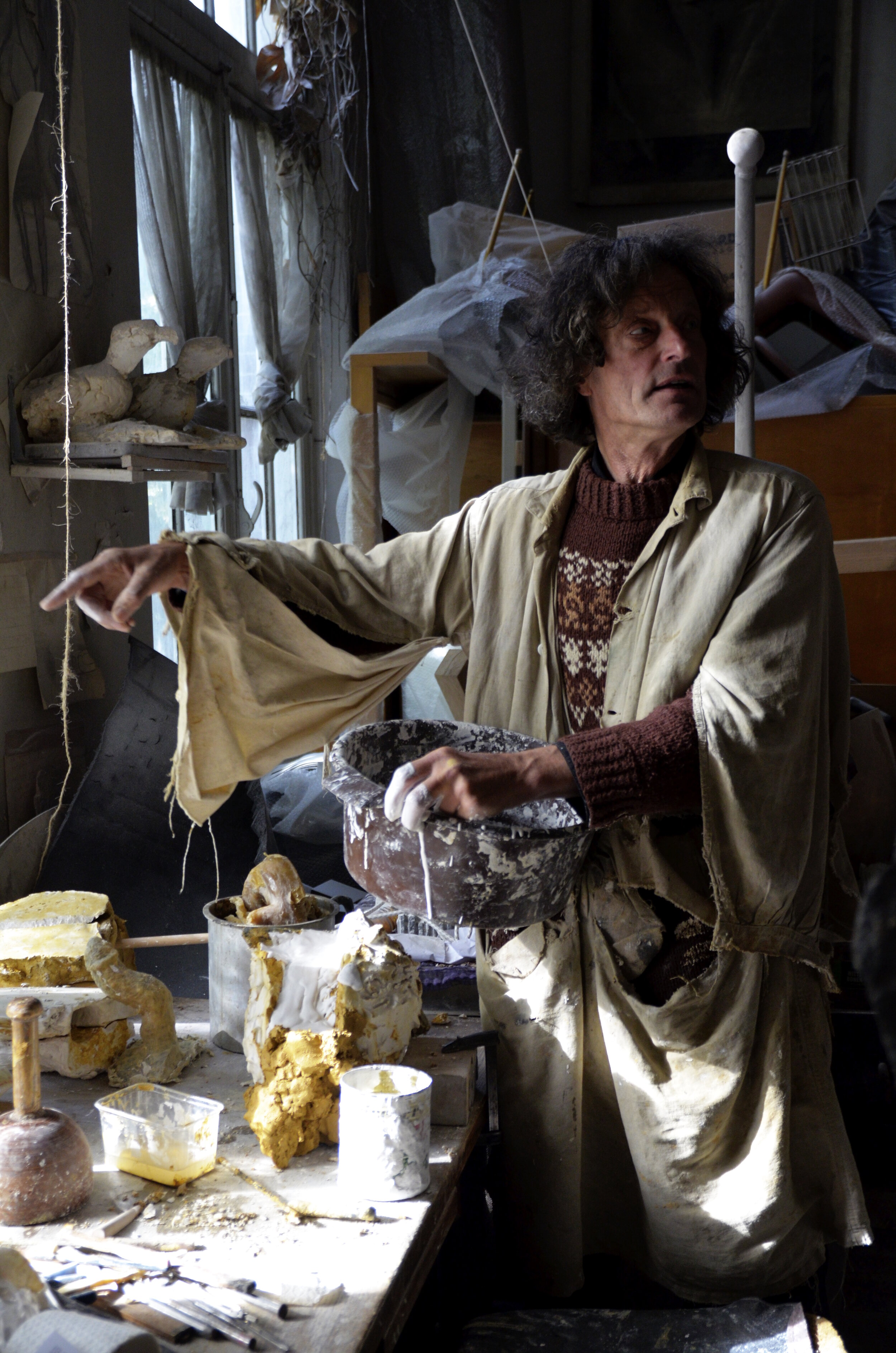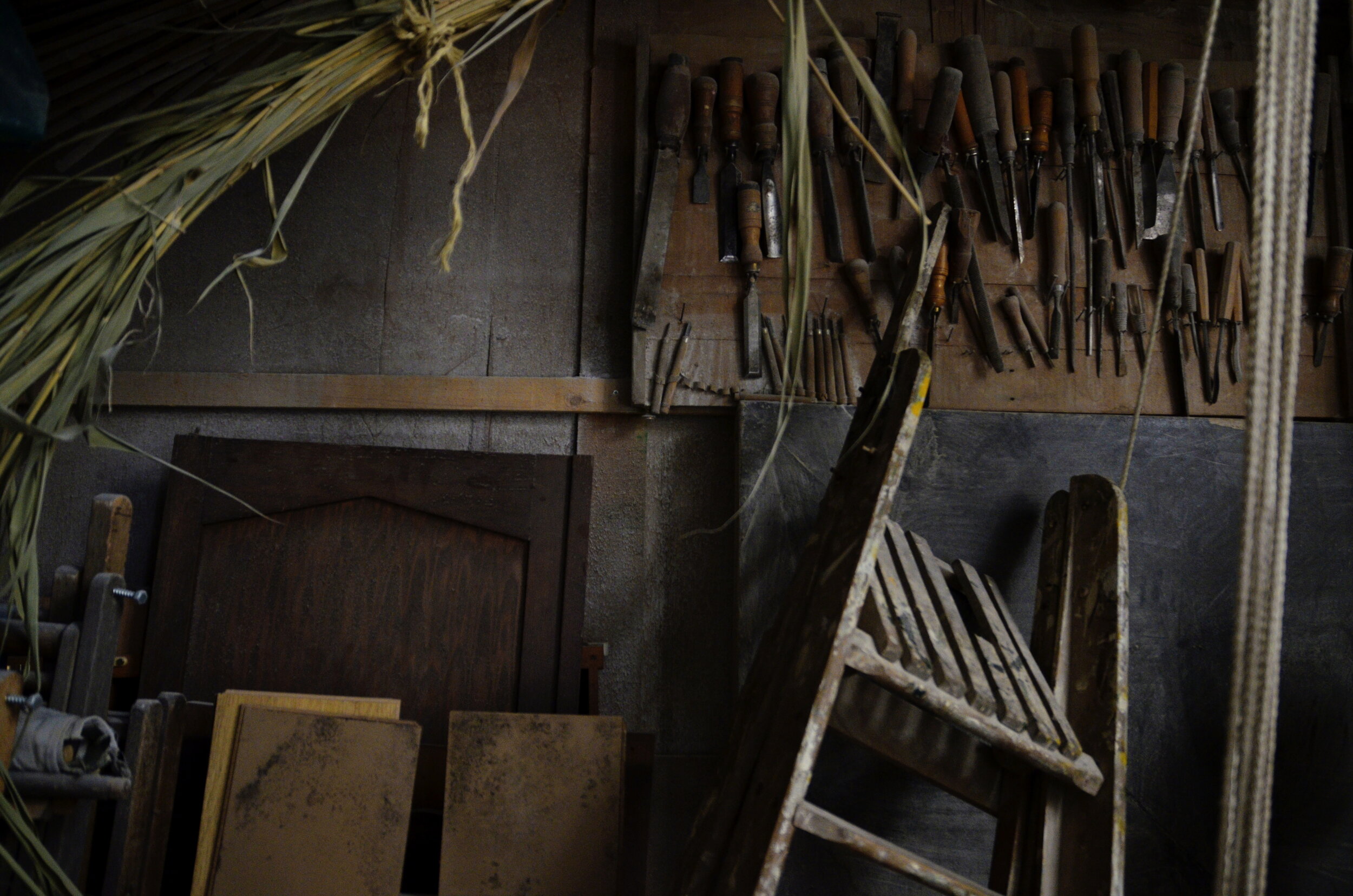A Talk with Loek Schönbeck – Typographer, Sculptor, Crafter of Tombstones
Photos by Angelo Zinna
“Confusion is my business.”
When I arrive Schönbeck asks, “Do you mind if I keep on working—we can just talk over a bit? This is a very difficult mould.” He mixes plaster with water and fingers the sticky result over an ambiguous mass that’s already turned firm on the desk.
Schönbeck has called atelierWG, a complex of artist studios located in the former Wilhelmina Gasthuis hospital building in Amsterdam, home for just over thirty years. In his studio, formerly a postnatal ward, he crafts sculptures, mulls over the importance of typefaces, and works as a grafstenenmaker (an artisan crafter of tombstones).
He aims to produce an aesthetic of antiquity with his design work. When on the topic of basalt, a substance from which he formed one of his commissioned tombstones, he says, “It’s been lying upon the earth for thirty million years. It’s very rough, so I couldn’t add clean cut letters because it would have been an alien element. So I had to make the letters seem as if they’d been there for a million years.”
His studio is a marvel of momentos that he has accumulated over the past three decades. He takes pride in the fact that the neighbours advise their visitors to take a peek. In a city where interior design is encouraged to be as ordered as possible, a room such as this takes on a near mythic quality.
Thanks to the chipping and carving, covering all his treasures is a layer of dust. Save a triangle of broken pane, even the windows are opaque due to the fine grains of various rocks and wood. He works on a computer as well, of course, but usually at the local cafe. It makes sense, a shiny, 21st Century object (such as my own phone-as-dictaphone) seems incongruous in such a treasure trove.
For his PhD thesis in Philosophy some 25 years ago, the theme of which was Heraclitus’s writings on the sun, he had to design his own typeface in order to complete it. The end result featured 3,500 characters that Schönbeck built from scratch. “Designing the typeface gave me optimal flexibility […] Even now, Unicode includes classic and modern Greek, but not archaic Greek.” They are working on it, apparently. He checks for the update every month. Upon presenting his doctoral thesis, he recounts some people supposing that “‘You’re either a genius or a liar!’”
He claims that his Greek is good enough to know that translations of the Bible are riddled with mistakes. “Last time I had to say Matthew 6: 9-13 at a burial, I just said it in Greek. I find it hard to translate, but at least the Greek words are right.”
“When I was six I could read new Greek, probably before I could even write Latin, so typography was exciting me from very early on,” he explains. “The purpose of the typeface for the thesis was to make the page quiet, to assist the reader in being able to focus more on the content than the presentation.”
His typographic inspiration is the 16th century humanist publisher Aldus Manutius. Schönbeck took a pilgrimage to Venice in order to study his original publications. “Modern typefaces are too refined for my tastes.”
“It’s all the same,” he says on the two disciplines: art and philosophy. “One year after being promoted at the UvA my Doctoral thesis was lying in the Stedelijk Museum as a piece of art.”
“On 15 January 1962, 10km north of Thessaloniki, Greece, a bulldozer uncovered an ancient, unlooted cist grave. In the following weeks another six graves were discovered. One of them contained a papyrus roll, carbonized among the debris of the funeral pyre that had been strewn over the slabs covering ‘Tomb A.’ The deceased man had been cremated on an elaborate structure very close to the tomb; his ashes and bones were placed in a bronze crater, which was also in the tomb. The grave was close to the shrine of Demeter and Kore.
Due to the combustion and the resulting carbonisation, the text was preserved because fungi have no grip on pure carbon; had it not been burned, it would have perished long ago. The outer surface of the roll was protected with partial remains of dried mud. In the beginning of the text there is a quotation of Heraclitus on the sun. That’s why it was part of my doctoral thesis.
The roll consists of 266 pieces. It is now lying in the Archeological Museum of Thessaloniki and, dated between 340-320 BC, is taken to feature the oldest known European handwriting. lt contains an Orphic poem describing one’s cosmological travelling after death.”
On being a grafstenenmaker, Schönbeck says, “When I was two years old I went a lot to the beach and I made sandcastles. That is how I started. You probably did, too. But the point is not that I continued, but that you didn’t!”
He points out that tombstones are not for the deceased, they’re “for the widows, mostly women, but sometimes men. For them it’s a process. I visit them [the graves] sometimes, and people still visit and leave things, such as flowers or so. They’re still living.”
“I’m also concerned with deciphering parpyric texts at the University of Utrecht. Some of them are from the 1st Century, some from the 6th Century, and some in between.” In translating these documents, utilising his knowledge of graphic styles alongside academics who specialise in linguistics, he helps to bring them back to life; the visual clues are unpicked and a text’s meanings are resurrected for a modern reader. His work with tombstones sits in this vein also. They give the deceased immortality through a combination of sculpture and typography.
Schönbeck’s enthusiasm extends into a conversation about his most recent art exhibition, an eco-minded exhibit of Marlboro packets found on the street. “5,000,” I’m told. He took this piece to Bergen op Zoom, where Philip Morris has an office.
“There’s this Dutch proverb that says: ‘A bird does not make his own nest dirty.’ So if people leave the packet on the street, but the street is not their nest, then this is a social-political problem—which has little attention. It also has something to do with lack of interest in the surroundings. And I was just drawing attention to one’s own lack of interest. I’m guessing that people who feel well don’t litter on the street.”
He hands us a calling card. It looks as old as the room—no surprises there. I ask what the Coat of Arms printed on the top left is a reference to. He replies that it’s his family’s ancestral emblem, a line of aristocratic Germans, dating back to at least the 17th Century.
Every time one layer of intrigue dries up, a new layer is poured on top.











